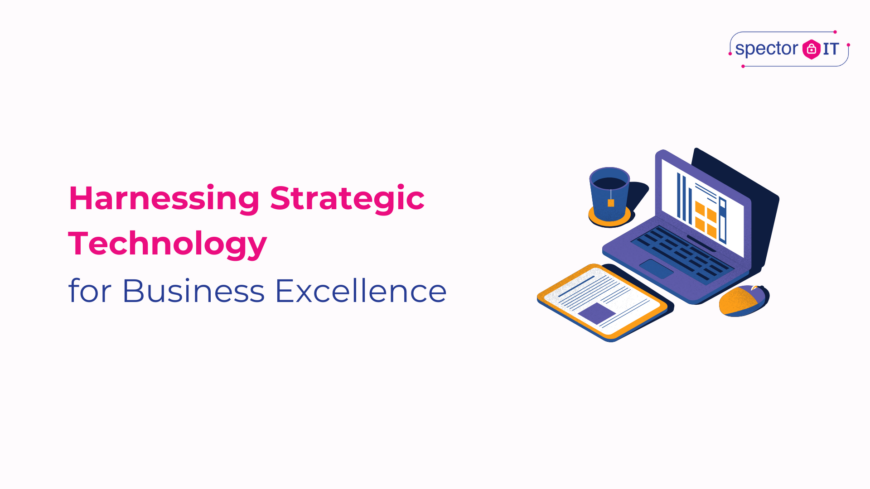
Harnessing Strategic Technology for Business Excellence: A Guide to Success
In today’s rapidly evolving market landscape, technology is not just an operational tool but a pivotal driver of business success. The journey toward leveraging technology effectively, however, can be complex, especially for companies entangled in transactional or siloed approaches to their tech investments. Such perspectives often lead to inefficiencies, with businesses grappling with escalating costs and a lack of coherence in their technology strategy.
Gap Analysis
Reflecting on this, the first step we take is a deep, introspective look at where our clients stand technologically and where we aspire them to be in the next one to three years.
This process, known as Gap Analysis, became our compass, as understanding the critical role of technology in business growth necessitates a strategic overhaul.
This process involves evaluating the current state of your:
Strategic Business Alignment
In today’s rapidly evolving digital landscape, the alignment of business strategy and technology is not just beneficial; it’s imperative for organisations aiming to achieve sustainable growth and competitive advantage. The concept of Strategic Business Alignment focuses on harmonising an organisation’s technology investments with its business goals, ensuring that every technological advance propels the business forward. This alignment is crucial for bridging the technology gap, a divide that can hinder an organisation’s ability to adapt, innovate, and ultimately succeed in the modern marketplace.
The Essence of Strategic Business Alignment
At the core of Strategic Business Alignment is the understanding that technology should not exist in isolation from the business it serves. Instead, technology should be a driving force that supports and enhances the organisation’s objectives. This paradigm shift requires a deep integration of IT strategies with overall business strategies, ensuring that every technological initiative, from software development to IT infrastructure upgrades, is directly linked to achieving specific business outcomes.
Key Vendor Relationships
In an era where technology is a pivotal force in driving business success, the relationships companies maintain with their technology vendors have never been more critical. These key vendor relationships stand at the heart of an organisation’s ability to innovate, adapt, and excel in a competitive marketplace. As businesses strive to bridge the technology gap—a divide that can significantly impact their operational efficiency and market relevance—fostering strategic partnerships with technology vendors emerges as a vital strategy.
The Role of Vendor Relationships in Bridging the Technology Gap
The technology gap refers to the disparity between an organisation’s current technological capabilities and the potential it must reach to meet market demands or achieve strategic goals. Bridging this gap is essential for businesses looking to leverage technology for growth, innovation, and competitive advantage. Key vendor relationships play a crucial role in this process by providing access to cutting-edge technologies, expertise, and support that might otherwise be out of reach for many organisations.
IT Infrastructure & Cloud Services
In the quest to bridge the technology gap and drive business success, IT infrastructure and cloud services play a pivotal role. As businesses grapple with the need for agility, scalability, and efficiency, the transition to cloud-based solutions has become more than just a trend—it’s a strategic imperative. This shift not only addresses the immediate challenges of the technology gap but also lays the groundwork for future innovation and growth.
The Role of IT Infrastructure in Bridging the Gap
Traditional IT infrastructure often struggles to keep pace with the rapid changes and scalability demands of modern business environments. This is where cloud services come into play, offering a flexible, scalable, and cost-effective solution. By leveraging cloud services, businesses can:
- Enhance Scalability: Cloud services provide the ability to scale resources up or down based on demand, ensuring businesses can handle growth and fluctuations without the need for significant upfront investments in physical infrastructure.
- Improve Agility: The cloud enables businesses to deploy and update applications quickly, experiment with new ideas, and adapt to market changes more efficiently, fostering an environment of continuous innovation.
- Reduce Costs: With cloud services, companies can move from a capital expenditure (CapEx) model to an operational expenditure (OpEx) model, paying only for the resources they use. This can significantly reduce IT costs while freeing up capital for other strategic investments.
- Enhance Collaboration: Cloud services facilitate better collaboration both within organisations and with external partners, enabling real-time sharing and editing of documents and streamlining communication across geographical boundaries.
Cybersecurity Measures
In an age where digital transformation shapes the landscape of global business, cybersecurity has emerged as a foundational pillar for bridging the technology gap and ensuring sustained business success. As organisations leverage new technologies to enhance operational efficiency, innovate products and services, and engage with customers, the sophistication and frequency of cyber threats have also escalated. Bridging the technology gap, therefore, is not solely about adopting advanced technologies but also about implementing robust cybersecurity measures to protect these technologies and the valuable data they handle.
The Critical Role of Cybersecurity in Modern Business
Cybersecurity measures are no longer optional; they are essential for safeguarding business assets, maintaining customer trust, and ensuring the integrity of digital operations. The consequences of cybersecurity breaches extend beyond immediate financial losses to include long-term reputational damage, legal liabilities, and compromised intellectual property.
Business Continuity Planning
In today’s fast-paced and increasingly digital business environment, the ability to maintain continuous operations in the face of unexpected disruptions is more critical than ever. Business Continuity Planning (BCP) represents a strategic approach to ensuring that organisations can quickly recover from disruptions while minimising impact on operations, reputation, and revenue. As businesses work to bridge the technology gap—that is, the divide between current operational capabilities and those needed to compete effectively in a digital marketplace—BCP emerges as a crucial element for sustaining growth and ensuring long-term success.
Understanding the Importance of Business Continuity Planning
At its core, Business Continuity Planning is about proactive risk management. It involves identifying potential threats to operations, such as natural disasters, cyber-attacks, or supply chain disruptions, and developing plans to mitigate these risks. Effective BCP ensures that critical business functions can continue during and after a crisis, safeguarding both the short-term operational capacity and the long-term viability of the organisation.
Policies and Procedures
In the modern business landscape, where technology evolves at an unprecedented pace, the importance of having robust policies and procedures cannot be overstated. These guiding documents play a critical role in bridging the technology gap, ensuring that organisations can not only adopt new technologies efficiently but also manage the risks and challenges that come with digital transformation. As businesses strive for success in a competitive and rapidly changing environment, well-defined policies and procedures become the blueprint for sustainable growth and innovation.
The Foundation of Effective Technology Management
At the heart of bridging the technology gap is the ability of an organisation to manage its technology resources effectively. This involves more than just acquiring the latest tools and systems; it requires a structured approach to integrating technology into the business processes, safeguarding data, and promoting a culture of compliance and best practices. Policies and procedures provide this structure, offering clear guidelines on the use, management, and security of technology.
Strategic Alignment and Governance
One of the key benefits of having well-crafted policies and procedures is their role in ensuring strategic alignment between technology initiatives and business objectives. By defining how technology decisions are made, who is responsible for these decisions, and how technology investments are aligned with the overall business strategy, organisations can ensure that their technology efforts are directly contributing to their success.
Furthermore, policies and procedures establish a framework for governance, ensuring that technology resources are used responsibly and efficiently, and that risks are managed proactively. This governance framework is essential for maintaining operational integrity, compliance with laws and regulations, and the trust of customers and stakeholders.
The Shift
By identifying and addressing these gaps, companies can streamline their operations, enhance productivity, and ensure their technology investments are directly contributing to their strategic objectives. Transitioning from a fragmented to a unified technology approach enables organisations to achieve standardisation, operational efficiency, and a competitive edge.
Consider the transformative journey of a professional services client with offices across Europe. Initially hindered by decentralised technology decisions, the company faced significant challenges in maintaining efficiency and alignment. By adopting a unified technology strategy, they not only streamlined their operations but also set a foundation for sustainable growth, despite the initial resistance and the complexities involved in transitioning from legacy systems.
This narrative underscores the essence of a strategic technology roadmap, which lies in simplifying and standardising processes while effectively managing change. It’s about fostering a culture that embraces technological advancements and aligns them with business goals to drive efficiency, innovation, and collaboration. Key to this journey is involving all stakeholders in the change process, prioritising cybersecurity to protect valuable data and systems, and seeking external expertise when the scope of transformation exceeds internal capabilities.
In crafting a technology roadmap, businesses embark on a strategic endeavour that requires foresight, collaboration, and adaptability. It’s about envisioning an ideal future state where technology not only supports but accelerates business objectives, navigating the complexities of digital transformation with a clear purpose, and adopting a proactive approach to change.
As businesses navigate the intricacies of technology integration, the value of a well-constructed roadmap becomes increasingly apparent. It acts as a beacon, guiding companies toward technological empowerment and enabling them to harness the full potential of their digital investments. In an age where technology dictates market dynamics, a strategic approach to technology planning is not just beneficial; it’s imperative for success.
Contact us today to schedule a no-commitment Discovery Call to discuss how we can help you strategise technology roadmap and get your company ready for the future.
Many thanks for reading! To learn more about Business Technology, read our blogs.

